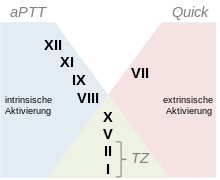Partial thromboplastin time
The partial thromboplastin time ( PTT , English P artial T hromboplastin T ime ), often short for Activated partial thromboplastin time ( aPTT , a ctivated P artial T hromboplastin T ime ), is a test to check the intrinsic coagulation system . It is an important control parameter in heparin or thrombolytic therapy and for the detection of coagulation disorders.
It is to be distinguished from the thromboplastin time (TPZ) (without the addition "partial" - measures the extrinsic coagulation) and from the plasma thrombin time (PTZ) (isolated test of the common end distance).
execution

To measure the PTT is in the laboratory to previously anticoagulated citrate blood clotting by the addition of phospholipids (also outdated: partial thromboplastin or platelet factor 3, a protein-free phospholipid ), (eg. Of a surfactant kaolin ) and calcium ions in motion again is set and the time until coagulation occurs is determined.
The normal value in healthy people is 20 to 38 seconds.
The PTT is extended u. a. at
- a deficiency in coagulation factors I, II, V, VIII ( hemophilia A ), IX ( hemophilia B ), X, XI, XII, HMWK ( Fitzgerald factor ) and prekallikrein ( Fletcher factor )
- a vitamin K deficiency or under Marcumar therapy, as the coagulation factors II, VII, IX and X are affected
- a heparin therapy
- some forms of Willebrand-Jürgens syndrome
- Antiphospholipid Syndrome
In contrast, deviations in the platelet count have no effect on the PTT, since the z. B. platelet factor 3 derived from platelets is added extra.
A shortened PTT is likely to be of no clinical significance.